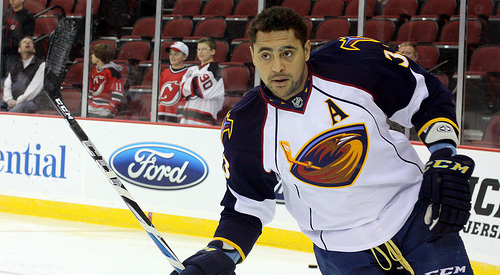
Believing in the 2011-12 Winnipeg Jets
On April 28, 1996, the Winnipeg Jets lost 4-1 to the Detroit Red Wings. Despite the loss, the crowd in Winnipeg Arena waved a sea of white towels as well as a standing ovation for the home team.
The crowd knew the loss marked both the Jets’ elimination from the Stanley Cup playoffs and, more painfully, the NHL’s departure from the entire province of Manitoba.
Much to everyone’s disbelief, 15 years later, the Jets are back in Winnipeg — albeit not the original Jets that left — and the energy in the city can be felt nationwide.
Just having the NHL back in Winnipeg is thrilling enough, but what type of hockey team has the city inherited? And could they actually make the playoffs in their first year back in the ‘Peg?
Last year the Atlanta Thrashers jumped out of the gate with an impressive record that took them as high as sixth in the Eastern Conference. In early January, however, the squad began its lengthy slide, which resulted in a paltry 12 wins in their final 39 games.
They finished in 12th place with 80 points, 13 shy of the final playoff spot.
[php snippet=1]
If the Jets are going to make a substantial jump in the standings in 2011-12, they will foremost need to improve their goals against. The Thrashers ranked second-last in the NHL last season in said category, allowing an average of 3.2 goals per game, making them one of only five teams to allow more than three goals a game.
One reason the Jets are hopeful they can improve in this area is simple: goaltending. Ondrej Pavelec improved during his second full season in the NHL, producing a respectable .914 save percentage, up from .906 during his rookie campaign. The young netminder held an even stronger save percentage during his first 28 games with a sparkling .936, but faltered down the stretch, coinciding with the Thrashers’ drop in the standings.
With another year under his belt as the starter, Pavelec should be better able to combat any fatigue he may have felt late in 2010-11. But Pavelec won’t be able to do it by himself; the defense will need to improve exponentially.
The Jets boast two of the NHL’s most dynamic and young offensive defensemen in Dustin Byfuglien and Tobias Enstrom.
Together, they amassed over 100 points last season, but neither has developed a top-line defensive game to accompany their offensive skills. What’s important to remember about last season, however, is that it was Byfuglien’s first full NHL campaign on defense after primarily being used as a power-forward in Chicago. Moving forward, his defensive game should continue to develop, helping the Jets make substantial improvements in their own zone.
The Jets’ other cause for hope on the blueline, Zach Bogosian, has all the makings of a true No.1 defenseman. He’s big, he’s fast, and he’s strong, but he has yet to improve on a promising rookie campaign. That could all change with the right mix of experience and teaching young Bog the ropes.
Aside from what’s been noted above, what really could change the fortunes of the Jets is if they find a way to improve on a penalty kill that operated at 77.5 percent efficiency last year; fourth worst in the NHL.
This will be the major task of new coach Claude Noel, a former AHL Coach of the Year, whose most recent NHL gig was apprenticing under defensive specialist Ken Hitchcock in Columbus. This experience should prove invaluable in helping turn around the penalty kill, as should Noel’s penchant for molding hard-working teams.
Up front, the Thrashers did not produce a single 60-point player last season. And although Andrew Ladd narrowly missed said plateau in 2010-11, they have two key players primed for breakout seasons.
Evander Kane is one, as he jumped almost 20 points in his sophomore season and was just shy of hitting the 20-goal mark. Then there is relatively-new acquisition Blake Wheeler, who potted 17 points in 23 games for the Thrashers after being acquired at the deadline from the Bruins.
Both players were taken with top-five selections in the NHL Entry Draft and have the opportunity to shed the label of being “developing prospects” this season.
Kane and Wheeler are actually a part of the youngest roster in the league, which, as last year showed, creates a sizable hurdle when attempting to hold onto a playoff spot.
If the Jets need a recent example of a team that surprised many, they must look no further than the team that originally left Winnipeg: the Phoenix Coyotes. The Coyotes made the playoffs the last two seasons after years of mediocrity by combining a mix of excellent coaching, hard-work, and stellar goaltending. They improved their goal differential by nearly 70 points in the first year after hiring Dave Tippett as head coach.
Hopefully a new coaching philosophy and a young roster can help the Jets emulate their Western cousin’s success.
There hasn’t been an NHL playoff game in Winnipeg since 1996, and it certainly isn’t a given that there will be any in 2012, but the people of Winnipeg finally have more than hope — they have a shot, and after 15 long years, they’ll take it.
[php snippet=1]

